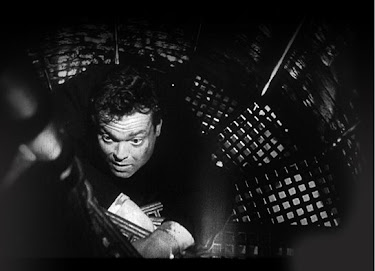Written by: Vladimir Pozner (story), Nunnally Johnson (written by)
Psychology is a dubious science as it is, but, when a Hollywood screenwriter gets his hands on it, anything even closely resembling fact is thrown out the window. In the mid-1940s, Freudian psychology reached the peak of its popularity, and films such as Hitchcock's Spellbound (1945) and Lang's Secret Beyond the Door… (1947) utilised their own versions of psychoanalysis to provide easy answers for their characters' delusions. Robert Siodmak's The Dark Mirror (1946) is no different, in that we are offered a half-baked pseudo-scientific dissertation on why even identical twins can be anything but identical when it comes to personality traits. In fact, screenwriter Nunnally Johnson (who also wrote and directed The Three Faces of Eve (1957)) actively pumps the familiar but questionable notion that twins respectively represent the good and evil sides of man. This duality is similar to that explored in the earlier versions of Dr. Jekyll and Mr. Hyde (1920/1931/1941), though the two sides of the human coin are here separated from their mutual shell and allowed to behave as independent entities.
 Olivia de Havilland excels in dual roles as Terry and Ruth Collins, twin sisters who might just have pulled off the perfect crime, even if only one knows it. When the sisters' shared boyfriend is murdered in cold blood, two witnesses place one of the twins at the scene of the crime, while three more provide a solid alibi for the other. The only problem is that nobody can tell the pair apart. A police detective (Thomas Mitchell) is torn apart by the case: how can he charge either woman with murder if he can't decide which of the sisters is, in fact, a murderess? Only through Hollywood's good friend Dr. Freud can the true nature of the crime be exposed. The distinction between the "good" and "insane" twin is clearly drawn early in the film, with de Havilland playing one sister as a cocky dominator, and the other as more softly-spoken, with eyes always downcast and hands delicately clasped together. Clarifying the dual relationship is some convenient symbolism used in the film's climax: Terry is dressed in black, and Ruth in white.
Olivia de Havilland excels in dual roles as Terry and Ruth Collins, twin sisters who might just have pulled off the perfect crime, even if only one knows it. When the sisters' shared boyfriend is murdered in cold blood, two witnesses place one of the twins at the scene of the crime, while three more provide a solid alibi for the other. The only problem is that nobody can tell the pair apart. A police detective (Thomas Mitchell) is torn apart by the case: how can he charge either woman with murder if he can't decide which of the sisters is, in fact, a murderess? Only through Hollywood's good friend Dr. Freud can the true nature of the crime be exposed. The distinction between the "good" and "insane" twin is clearly drawn early in the film, with de Havilland playing one sister as a cocky dominator, and the other as more softly-spoken, with eyes always downcast and hands delicately clasped together. Clarifying the dual relationship is some convenient symbolism used in the film's climax: Terry is dressed in black, and Ruth in white. Convincing optical effects and the use of body doubles are employed successfully to create the illusion of two Olivia de Havillands. The actress does well as both characters, perhaps channelling her dislike of sister Joan Fontaine to portray the snarling, psychotic and homicidally jealous "evil sister." Though they start out perfectly alike, it doesn't take long for the two Collins sisters to develop distinct personalities in the eyes of the audience, and Siodmak should quickly have dispensed with the obvious name-tags (either a necklace or a single letter pin) added to ensure that the audience could follow who was who. Perhaps misguidedly, the presence of twins is at first played largely for laughs, with composer Dimitri Tiomkin keeping the atmosphere surprisingly light and fluffy. Fortunately, however, the mood darkens substantially in the film's second half, as the hatred simmering slowly within the darker twin threatens to spill over into reality. Though the unlikely psychology behind The Dark Mirror tests one's credulity at regular intervals, the strong acting and unique storyline make this one worth seeking out.
Convincing optical effects and the use of body doubles are employed successfully to create the illusion of two Olivia de Havillands. The actress does well as both characters, perhaps channelling her dislike of sister Joan Fontaine to portray the snarling, psychotic and homicidally jealous "evil sister." Though they start out perfectly alike, it doesn't take long for the two Collins sisters to develop distinct personalities in the eyes of the audience, and Siodmak should quickly have dispensed with the obvious name-tags (either a necklace or a single letter pin) added to ensure that the audience could follow who was who. Perhaps misguidedly, the presence of twins is at first played largely for laughs, with composer Dimitri Tiomkin keeping the atmosphere surprisingly light and fluffy. Fortunately, however, the mood darkens substantially in the film's second half, as the hatred simmering slowly within the darker twin threatens to spill over into reality. Though the unlikely psychology behind The Dark Mirror tests one's credulity at regular intervals, the strong acting and unique storyline make this one worth seeking out.7/10
Currently my #4 film of 1946:
1) It’s A Wonderful Life (Frank Capra)
2) The Big Sleep (Howard Hawks) *
3) Notorious (Alfred Hitchcock) *
4) The Dark Mirror (Robert Siodmak) *
5) The Blue Dahlia (George Marshall) *
2) The Big Sleep (Howard Hawks) *
3) Notorious (Alfred Hitchcock) *
4) The Dark Mirror (Robert Siodmak) *
5) The Blue Dahlia (George Marshall) *





_poster.jpg)


No comments:
Post a Comment